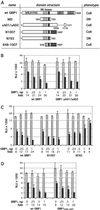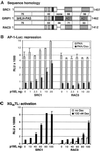Alternate surfaces of transcriptional coregulator GRIP1 function in different glucocorticoid receptor activation and repression contexts
- PMID: 12481024
- PMCID: PMC139207
- DOI: 10.1073/pnas.262671599
Alternate surfaces of transcriptional coregulator GRIP1 function in different glucocorticoid receptor activation and repression contexts
Abstract
Members of the mammalian p160 family, such as GRIP1, are known as glucocorticoid receptor (GR) coactivators; at certain glucocorticoid response elements (GREs), however, GRIP1 acts as a GR corepressor. We characterized functional interactions of GR and GRIP1 in a repression complex where GR tethers to DNA-bound activator protein-1 (AP-1), as at the human collagenase-3 gene, and tested whether the identified interactions were similar or different at other response elements. At the AP-1 tethering GRE, we mapped the GRIP1 corepressor activity to a domain distinct from the two known GRIP1 activation domains; it exhibited intrinsic GR-independent repression potential when recruited to DNA via Gal4 DNA-binding domain. Interestingly, neither the domain nor the activity was detected in the other two p160 family members, SRC1 and RAC3. The same GRIP1 corepression domain was required for GR-mediated repression at the nuclear factor-kappaB (NF-kappaB) tethering GRE of the human IL-8 gene. In contrast, at the osteocalcin gene GRE, where GR represses transcription by binding to a DNA site overlapping the TATA box, both GRIP1 and SRC1 corepressed, and the GRIP1-specific repression domain was dispensable. Thus, in a single cell type, GR and GRIP1 conferred one mode of activation and two modes of repression by selectively engaging distinct surfaces of GRIP1 in a response element-specific manner.
Figures





References
-
- Hu X. & Lazar, M. A. (2000) Trends Endocrinol. Metab. 11, 6-10. - PubMed
-
- Freedman L. P. (1999) Cell 97, 5-8. - PubMed
-
- Malik S. & Roeder, R. G. (2000) Trends Biochem. Sci. 25, 277-283. - PubMed
-
- Yamamoto K. R., Darimont, B. D., Wagner, R. L. & Iniguez-Lluhi, J. A. (1998) Cold Spring Harbor Symp. Quant. Biol. 63, 587-598. - PubMed
-
- Lefstin J. A. & Yamamoto, K. R. (1998) Nature 392, 885-888. - PubMed
Publication types
MeSH terms
Substances
LinkOut - more resources
Full Text Sources
Molecular Biology Databases
Research Materials
Miscellaneous

